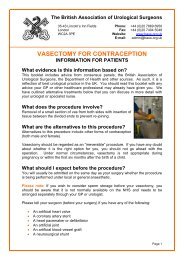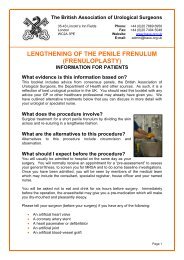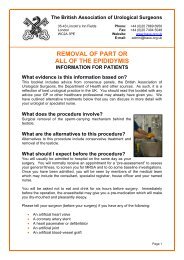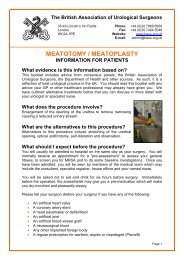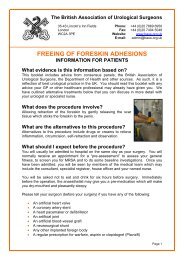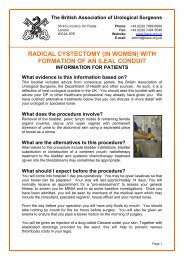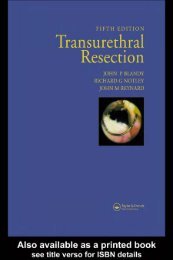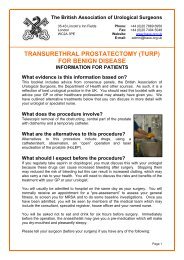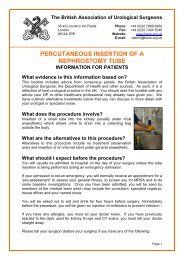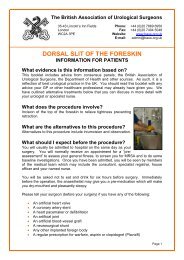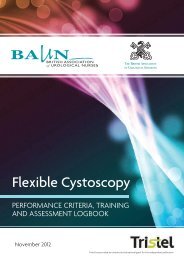MDT (multi-disciplinary team) guidance for managing prostate cancer
MDT (multi-disciplinary team) guidance for managing prostate cancer
MDT (multi-disciplinary team) guidance for managing prostate cancer
Create successful ePaper yourself
Turn your PDF publications into a flip-book with our unique Google optimized e-Paper software.
Assessment and Diagnosis<br />
Screening<br />
• PSA screening remains a relatively contentious subject in the field of <strong>prostate</strong> <strong>cancer</strong>. It is felt that<br />
robust evidence is lacking concerning whether screening results in a reduction in mortality from<br />
the disease.<br />
• Three ongoing large, randomised, controlled clinical trials are evaluating the value of PSA<br />
screening <strong>for</strong> <strong>prostate</strong> <strong>cancer</strong>: the European Randomised Study of Screening <strong>for</strong> Prostate Cancer<br />
(ERSPC), 5 the Prostate, Lung, Colorectal and Ovarian (PLCO) <strong>cancer</strong> screening trial in the US6<br />
and the UK-based Prostate Testing <strong>for</strong> Cancer and Treatment (ProtecT) study. 7 The first reports<br />
from these trials have been published and have added further in<strong>for</strong>mation to the PSA screening<br />
debate:<br />
o The PLCO study reported no mortality benefit with the combination of PSA screening and<br />
digital rectal examination (DRE) during a median follow-up of 7 years. 6<br />
o In contrast, the ERSPC trial found that PSA screening was associated with a 20% relative<br />
reduction in <strong>prostate</strong> <strong>cancer</strong> mortality at a median follow-up of 9 years, equivalent to the<br />
prevention of approximately 7 <strong>prostate</strong> <strong>cancer</strong> deaths per 10,000 men screened. This mortality<br />
benefit was associated with a high risk of overdiagnosis, with nearly 76% of men who<br />
underwent a biopsy following an elevated PSA value having a false positive result. 5<br />
o ProtecT has demonstrated a benefit of repeat PSA testing in reducing the risk of high-grade<br />
<strong>prostate</strong> <strong>cancer</strong> in men with an initial PSA concentration of 3−20 ng/ml. 7<br />
• Quality of life and cost-effectiveness analyses from the ERSPC and PLCO trials, along with<br />
mortality results from ProtecT are needed to help resolve the ongoing PSA screening debate.<br />
Risk factors <strong>for</strong> <strong>prostate</strong> <strong>cancer</strong><br />
The risk factors <strong>for</strong> <strong>prostate</strong> <strong>cancer</strong> are generally well-documented, but are highlighted here <strong>for</strong><br />
completeness of the Guidance.<br />
• Age<br />
o Relatively rare in men under the age of 50 years.<br />
o Incidence increases in those over 60 years.<br />
• Race<br />
o A higher incidence of the disease is seen in African-Caribbean, African-American and West<br />
African races. The UK PROCESS study is compiling equivalent UK data. 8<br />
o Men of Chinese and Japanese origin have a low incidence of disease.<br />
• Geography<br />
o The highest incidence of <strong>prostate</strong> <strong>cancer</strong> is currently seen in North America and<br />
Northern Europe.<br />
• Family history<br />
o Men with a first-degree relative affected by <strong>prostate</strong> <strong>cancer</strong> have a relative risk of<br />
developing the disease themselves 2-fold greater than men with no relatives affected. 9<br />
o Those men with an affected second-degree relative have an increased relative risk<br />
of 1.7 of developing the disease.<br />
o Men with both a first- and second-degree relative affected have an increased relative<br />
risk of 8.8 of developing the disease.<br />
13



